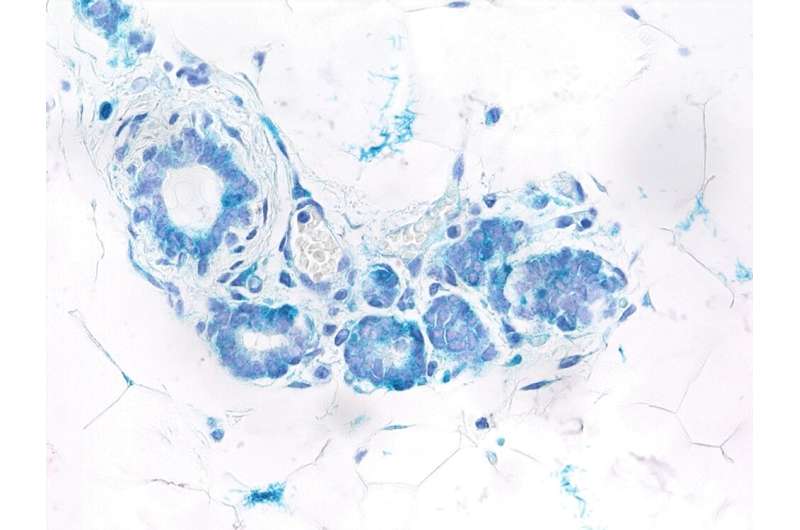

Early diagnosis and improvement of breast cancer treatments have reduced breast cancer mortality in recent years, with survival rates reaching 85% today. In spite of these data, breast cancer was still the most frequently diagnosed tumor in the world in 2020, mainly due to increased population screening and social factors such as aging. RANK protein plays a key role in the development of these tumors. Located in the membrane of cells, when it binds to its partner RANKL, it sends signals that stimulate the development of the mammary gland. When these proteins do not work properly, breast cells begin to divide and multiply uncontrollably, resulting in breast cancer.
Researchers from the Spanish National Cancer Research Centre (CNIO) and the Bellvitge Biomedical Research Institute (IDIBELL), led by Eva González-Suárez at the CNIO, have found that the hyperactivation of the RANK pathway plays a double function in breast cells: In the early stages of cancer, it activates senescence, which has a protective effect and delays the appearance of tumors; in more advanced stages, RANK-induced senescence favors the accumulation of stem cells in the breast tissue, which promotes tumor growth and increased aggressiveness. The results of the work are published this week in the journal Developmental Cell.
The authors describe throughout the paper how this double activation of senescence and tumor stem cells occurs in response to high RANK levels, using mice that produced large amounts of this protein in the epithelial cells of breast tissue. “We observe that high levels of RANK protein induce senescence and at the same time an accumulation of stem cells, which in principle seems contradictory, but is not,” explains González-Suárez.
RANK protein, from bone formation to cancer
RANK proteins have been linked to bone tissue remodeling, and blocking these proteins by means of inhibitors such as denosumab antibodies has been shown to be effective in the treatment of bone-related pathologies such as osteoporosis and bone metastases.
These proteins also participate in the development of the mammary gland, which occurs mainly in women during puberty, pregnancy and the menstrual cycle in response to sex hormones. When these proteins do not work properly, breast cells begin to divide and multiply uncontrollably. “In this paper, we have detected abnormally high levels of RANK in pre-neoplastic lesions in patients with breast cancer,” the researchers report. How does RANK act on epithelial cells in the mammary glands to promote cancer?
In 2010, González-Suárez first described the key role of this protein in the development of breast cancer and proposed that drug inhibition by means of RANKL inhibitors could prevent breast cancer. Over the course of a few years, “we demonstrated its therapeutic potential for the treatment of breast tumors by reducing recurrence and metastases, both because of its role in tumor cells and because of a reactivation of the anti-tumor immune response,” the researcher said.
A protective mechanism that becomes harmful
Senescence is a process historically associated with the protection of cells and tissues. Cells begin their senescence program in response to stimuli such as the activation of oncogenes (cancer-promoting genes), the absence or failure of anticancer genes, or the shortening of telomeres, the protein structures that protect the ends of chromosomes. All of these stimuli are harmful, and senescence causes cells to enter a state of lethargy to facilitate cell integrity. But today it is known that in addition to the protective role of senescence against the development of diseases such as cancer, it can be a double-edged sword and favor pathological processes; for example, in obesity and diabetes, it promotes the disease, increasing insulin resistance and inflammation.
In the paper published in Developmental Cell, the researchers have found that in the early stages of breast cancer, high levels of RANK protein in the breast epithelium in mice induce senescence and a delay in tumor development. In contrast, in more advanced stages of tumors, they observed that senescence favored the accumulation of stem cells in the breast tissue, leading to increased tumor growth and aggressiveness.
“The mammary gland contains stem cells, which are like primitive cells that have the ability to differentiate into different cell types and promote tumor formation and increase their metastatic capacity,” says González-Suárez. The researcher had already seen in previous studies that RANK promotes stem cell properties in the mouse mammary epithelia. Now, the authors of the study have for the first time in breast cancer linked senescence to an increase in the stem cell properties of RANK regulated tissue, and how this leads to an increase in tumor progression and aggressiveness.
Non-tumor cells that send signals to favor cancer
In this sequence of events in which RANK is activated, the team has observed that in the earliest stages of the disease, senescence was activated primarily in the luminal cells of the breast epithelium, those that are most exposed to the lumen of the breast ducts.
In the work they suggest that these senescent, non-tumor cells release a series of substances that act in a paracrine way—at a distance from neighboring cells—on luminal and basal cells, the latter of which are far from the lumen of the ducts. In response to this stimulus, luminal and basal cells acquire stem cell characteristics, and despite the misleading initial delay, the resulting tumors are more aggressive, growing rapidly, causing lung metastases.
Source: Read Full Article